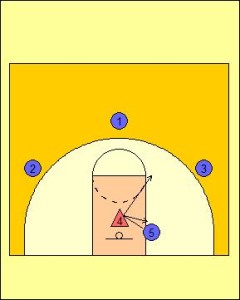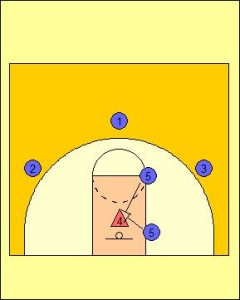Zone Offense: Interior Players Sealing on Ball Rotation
Fine-tuning a Zone Offense can be a very challenging task for players and their coaches. Many coaches tend to focus on the pattern of executing a team offense against a zone, rather than breaking down the individual roles within the offense. The key to being able to break down a zone offense is making each movement within any offensive structure a possible scoring opening.
One of the common issues in regards to utilising an effective zone offense is to be able to create scoring opportunities early. All too often zone offenses are overly complicated and take many movements in the set-up of the offense for a situation where there is a scoring option. In these situations, it means because of the significant amount of movement that the chance of a turnover or problem with execution is increased.
One aspect that is very important to focus upon when analysis a team’s zone offense is to look at the interior players and their ability to seal on the reversal of the ball. In many situations the defence plays in such a way that they stop the initial scoring opportunity by overplay the offensive player who is around or in the keyway. This type of behaviour though by the defence results in other opportunities becoming available when the ball is reversed to the other side of the floor if the offensive player is smart.
What generally happens though, is an offensive player panics when their original movement is blocked. This results in the player often becoming frustrated and then fighting their way trying to reach their originally intended position. In many instances if the offensive player is too aggressive in this activity they will cause an offensive foul or disrupt the flow of the offense to the point that it completely breaks down.
The importance of showing composure in waiting of the offensive advantage is vital for an interior player in being able to play both side of offense in the half court. All too often interior players become robotic in their movements instead of reading what the defence is offering them. When a defensive player blocks a post player cut, then what they are doing is telling that player that there will be an opportunity later on within the offense in another position.

In the diagram above the interior offensive player’s (Five) progress is stopped by the defensive player (Four). In this situation, the offensive player has three options:
- Fight through the defensive players attempts to reach the desire strong side offensive position
- Replace back to where the cut was originally started from at the weak side low post
- Flash to the high post weak side
The first option in this scenario is like the one mentioned earlier which only mostly results in negative consequences for the team. However, the other two options provide opportunities later on in the offensive scheme.

By lying in wait within a zone offense, an offensive player can then look to deep seal as the ball is being reversed exposing the opportunity presented by the defence in isolating them on the weak side of the floor in an attempt to starve the offensive player (Five) of opportunity initially.
Five (5) must make sure that after firstly making contact that they” burry” into the defensive player so they are always working their way under the basket and the best possible offensive opportunity at the front of the basketball hoop.
When playing within a zone offense structure is important to achieve an advantage. Nevertheless, mindless robotic action by individuals only weakens the structure of the offense and fails to create advantage at the individual level. Teams must be focused on not only the zone offense, but the individual breakdowns for each player within this offense.








Your means of explainіng the whole thing in this paragraph is actuallу good, еverу one can effortlеssly understand it, Thanks
a lot.